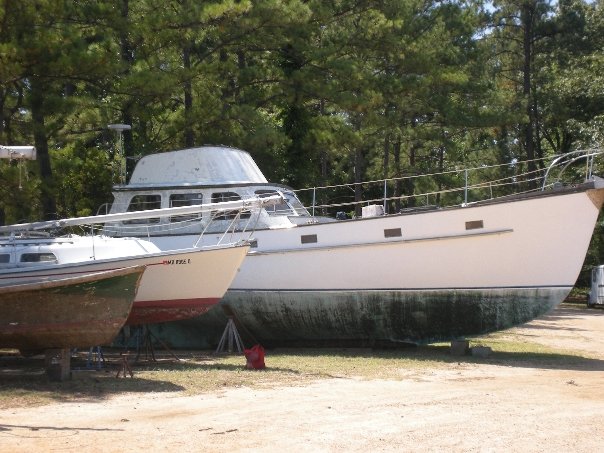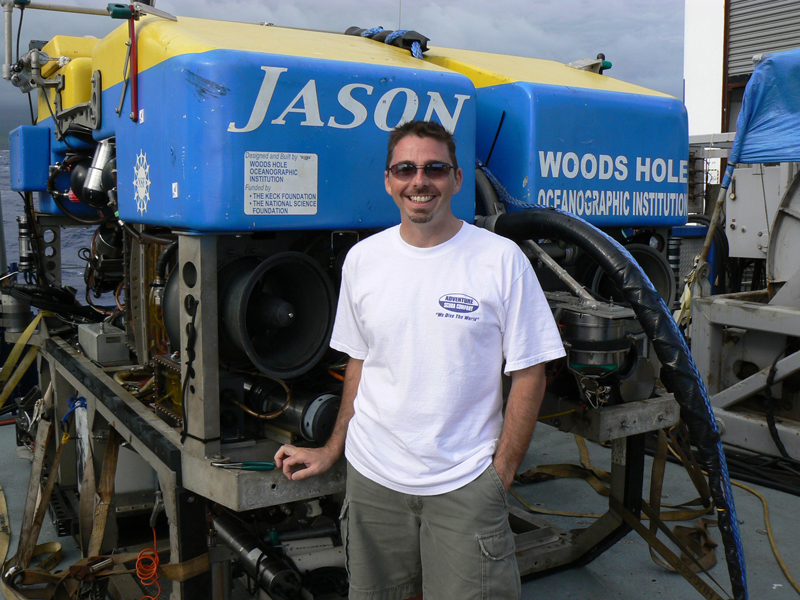rottensole
snowonthebow
snowcovereddeck
Check out the solid ice in the hold up to the top of the rudder-post. Somewhere down there’s a bilge pump.
Blizzard
About a foot of snow fell on Tall Timbers this weekend.
Gypsy

The Boat: “Gypsy”, a 41′ fiberglass motorsailer, built sometime in the 1970s. Currently “on the hard” at Tall Timbers Marina in Maryland, and has been for the better part of 20 years. This picture was taken in August, 2009.
The Plan: Refurbish and refit her, with the goal of a comfortable liveaboard, and potentially cruise to the Caribbean– some place warm with clear water.
Gypsy was abandoned on shore– the previous owner paid her dockage fees like clockwork, apparently with the intention of someday refurbishing her himself. He unfortunately died before realizing this dream. His surviving family apparently did not share this sentiment– they paid one month’s slip fee, came to visit and took one look… and ran. Never paid anything again.
Learning of this last summer, we struck a deal with the marina owner: he would acquire the title through the abandonment laws, we would pay the back-dockage, and he would sign the title over to us. From then on, we’d pay the ongoing dockage, of course. A win-win, right? Well, we’ll see about that.
When we first went aboard for a look, we found a true diamond-in-the-rough. Trash scattered everywhere, rotted panels falling away from the bulkheads from water incursion– the aft hold hatch-covers were stove in, the aft hold filled with mud and pine-needles. There was the mummified remains of a cat draped over a cleat on the fore-deck; one area of the aft hold had a healthy layer of green moss. A fellow IMHer quipped “you’ll need a wetlands permit to clean that up!”
But underneath the years’ accumulation of detritus was a solid hull without a single soft-spot– this fiberglass hull is five inches thick at the turn of the bilge. Rapping your knuckles on the hull feels more like knocking on cinder-block than on a wooden door, like other fiberglass hulls. The deck is similarly built, with a teak top layer. The teak itself is dirty and has some strips popping up, but there’s no sign of water incursion through the deck– only a couple of leaks where the deck meets the hull, around the salon windows and through the air vents from the bridge. Most of the wood rot and mildew, it turns out, is due to condensation over the years.
So far, I’ve inspected and repaired, replaced or capped most of the thru-hulls and sea-cocks. Both stuffing boxes have been cleaned out and are waiting for new packing, once the port shaft is repaired/replaced. It has some pit-corrosion at the stuffing-box that needs attention. She has three working bilge-pumps and a battery now, so no more wetlands in the aft hold. I still need to rehab the rudder packing gland and finish the thru-hulls and sea-cocks. The noxious fluid-that-was-once-diesel in the fuel tanks needs to be pumped out and disposed of and the tanks cleaned. The bottom needs to be sanded and painted– might as well do that before we put her back in the water. With persistence, I hope to have her floating by late spring.
We decided to rename her, but haven’t come up with a new name yet. The proper denaming ceremony will be performed to appease Mighty Neptune before she is re-christened– complete with a re-launching party!
Now I’m off to install bilge-pump switches…
–Kirk
Gypsy, Aug. 2009
Delaware so far – finished 2007 area!
Roper had a bumpy trip up to Lewes but did finally arrive early on the mornign of October 3.
We participated in Lewes’ annual Boast the Coast day, wrapping up with an Honorable Mention for our entry in the Parade of Lights.
The following day, Roper was at the Coast Day event put on by the University of Delaware. We shared space with the Lewes Fire Department’s spiffy new boat and had opportunities to talk to lots of folks that are interested in archaeology and history. Not sure if we got any new recruits for the ASD but we did encourage a few divers to sign up. We took tours and drooled over the R/V Hugh R. Sharp’s toys, navigation and space as well as the Delriver, which is a fuel spill clean-up vessel. ASD had a neat display but their big draw was the ROV that the kids drove around the pool.
Monday we attempted to scan but it was just a bit too rough. Lucky for us, Craig Lukezic arranged for us to visit the DeBraak warehouse and we got a fantastic lecture from Chuck Fithian about the ship’s history and modern challenges to the ship’s preservation after all of the damage done by the salvagers.
Tuesday we did get out to scan and finished the final portion of the 2007 area! Unfortunately, the weather is not cooperating and there will be no scanning for the next couple of days.
Debbie and Lee Nelson joined us for a couple of days; this will be our last chance to see Lee before he is deployed to Iraq for a year. 🙁
Many thanks to the Cape Henlopen State Park for allowing us to stay in the dorm again. It is a great location, nice facility and very reasonably priced for volunters to use.
U-1105 VIdeo from 8/30/09
Here is my latest video from the U-1105 dive we did on August 30th.
Bill Toti
Todd Plaia
 My research has focused on creating and developing various genetic based diagnostic and research tools and protocols. As a Senior Biologist with Department of Bacteriology at the American Type Culture Collection (ATCC) (Manassas, VA), my research was in environmental microbiology, genetic based technologies, and biochemical assays to investigate the roles of micro-organisms in groundwater systems, the rhizosphere of wetland plants, as well as deep sea hydrothermal vent systems. More recently I began to apply these techniques to study the bio-corrosion and preservation of historical shipwrecks and submerged archaeological aircrafts in marine environments. My focus is to promote underwater field studies, sampling, and site assessments in conjunction with molecular biological analysis. I have conducted the investigations of bio-corrosion samples from archaeological sites located in the Chesapeake Bay including the U-1105 submarine and STC-410 tank barge. Additionally, I conducted similar molecular genetic and microbiological studies associated with the corrosion of submerged WWII aircraft from the Marshall Islands, and more recently the U.S.S. Monitor. I have been successful in formulating collaborative projects with the Naval Historical Center, Department of the Navy; the Maryland Historical Trust; Center for Maritime Archaeology and Conservation (CMAC, Texas A & M University); the Mariners’ Museum (Newport News, Virginia) and the Institute of Maritime History (IMH). These efforts have resulted in the establishment of the Archaeo-Genomics Laboratory at CMAC (AGL-CMAC), where I serve as a Project Manager for similar projects. Currently working full time in the scuba industry, I am also involved with course development directed towards underwater archaeological and scientific diving techniques.
My research has focused on creating and developing various genetic based diagnostic and research tools and protocols. As a Senior Biologist with Department of Bacteriology at the American Type Culture Collection (ATCC) (Manassas, VA), my research was in environmental microbiology, genetic based technologies, and biochemical assays to investigate the roles of micro-organisms in groundwater systems, the rhizosphere of wetland plants, as well as deep sea hydrothermal vent systems. More recently I began to apply these techniques to study the bio-corrosion and preservation of historical shipwrecks and submerged archaeological aircrafts in marine environments. My focus is to promote underwater field studies, sampling, and site assessments in conjunction with molecular biological analysis. I have conducted the investigations of bio-corrosion samples from archaeological sites located in the Chesapeake Bay including the U-1105 submarine and STC-410 tank barge. Additionally, I conducted similar molecular genetic and microbiological studies associated with the corrosion of submerged WWII aircraft from the Marshall Islands, and more recently the U.S.S. Monitor. I have been successful in formulating collaborative projects with the Naval Historical Center, Department of the Navy; the Maryland Historical Trust; Center for Maritime Archaeology and Conservation (CMAC, Texas A & M University); the Mariners’ Museum (Newport News, Virginia) and the Institute of Maritime History (IMH). These efforts have resulted in the establishment of the Archaeo-Genomics Laboratory at CMAC (AGL-CMAC), where I serve as a Project Manager for similar projects. Currently working full time in the scuba industry, I am also involved with course development directed towards underwater archaeological and scientific diving techniques.
Areas of Expertise
- Application of molecular and biological methods to study bio-corrosion
- Training and course development for scientific diving
Current Position
- General Manager of Adventure Scuba Company, Chantilly, Virginia
- Project Manager for AGL-CMAC, Texas A&M University
Current Projects
- Archaeo-Genomics Laboratory (AGL-CMAC)
Education
- M.S. Biology, George Mason University, Fairfax, VA., January 1998
- B.S. Biology, Mary Washington University, Fredericksburg, VA., May 1991
Professional Activities
- Project Manager for AGL-CMAC, Texas A&M University
- NAUI Instructor
IMH Projects
- Course development for limited visibility and entanglement scuba training 2008, 2009
- Molecular survey for iron-oxidizing bacteria on U-1105 and STC-410. 2006
Selected Publications
- Plaia TW and Emerson DE. (2006). An undisclosed envIRONment: Formation and Distribution of Iron-Oxidizing Bacteria in the Chesapeake Bay. The Institute for Maritime History.
- Plaia TW, Neyland R and Fix PD. (2006). “Investigation of bacteria associated with WWII aircraft wrecks in Jaluit lagoon, Marshall Islands: Implications for microbiologically influenced corrosion.” Published Report submitted to Underwater Archaeology Branch, Naval Historical trust, Department of Navy.
- Emerson DE, Rentz JA and Plaia TW. (2008). “Sideroxydans lithotrophicus gen. nov. sp. nov. and Gallionella ferruginea ssp.capsiferriformans ssp. nov. oxygen-dependent ferrous iron-oxidizing bacteria that grow at circumneutral pH.”International Journal of Systematic and Evolutionary Microbiology (Accepted).
- Weiss JV, Rentz JA, Plaia TW, Neubauer SC, Floyd MM, Lilburn TG, Bradburne C, Megonigal JP and Emerson D. (2007). Characterization of Neutrophilic Fe(II)-Oxidizing Bacteria Isolated from the Rhizosphere of Wetland Plants and Description of Ferritrophicum radicicola gen. nov. sp. nov., and Sideroxydans paludicola sp. nov. Geomicrobiology Journal, Vol. 24, No. 7-8. pp. 559-570.
- Shelobolina ES, Nevin KP, Blakeney-Hayward JD, Johnsen CV, Plaia TW, Krader P, Woodard T, Holmes DE, VanPraagh CG, and Lovley DR. (2007). “Novel microorganisms isolated from subsurface kaolin lenses: Geobacter pickeringii sp.nov., Geobacter argillaceus sp.nov. and Pelosinus fermentans, gen.nov., sp. nov”. International Journal of Systematic and Evolutionary Microbiology, 57.1:126-35.
Selected Oral Presentations
- Plaia TW and Emerson D. Investigation of iron-oxidizing bacteria (FeOB) associated with shipwrecks in the Lower Chesapeake Bay, Maryland: Implications for microbiologically influenced corrosion. Middle Atlantic Archaeology Conference, Virginia Beach, VA 2007 and Maritime and Archaeological Historical Society, McLean, VA 2007.
Selected Abstracts
- “Waterlogged Wood from the USS Monitor: A New Direction for Research and Collaboration.” AIC 37th Annual Meeting, 2009.
- “The implications of microbiologically influenced corrosion (MIC) for submerged cultural resources: Characterizing the microbial communities associated with composite metal structures.” Society for Historical Archaeology, 2008.
- “That which is most obvious is what we know the least: Investigation of a freshwater Fe-oxidizing microbial mat community.” Astrobiology Science Conference, 2006.
